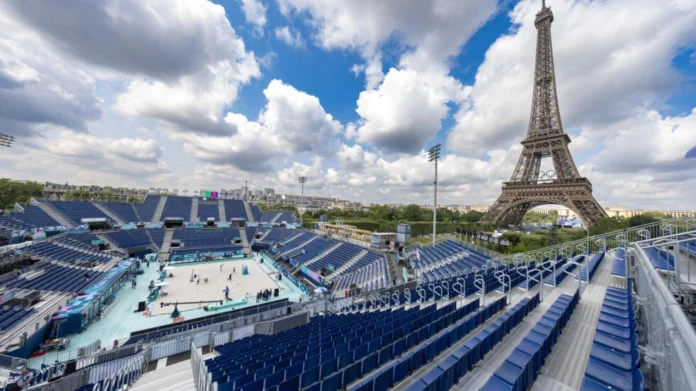
Paris, the City of Light, has long been associated with grandeur and innovation. As the host of the 2024 Olympics, Paris has embraced an ambitious sustainability strategy that aims to redefine how global sporting events manage their resources and environmental impact.
Under the guidance of Georgina Grenon, the sustainability director for Paris 2024, the Olympics are setting a new standard by focusing on the afterlife of the materials and equipment used during the games.
Rethinking Sustainability
“Before we ordered anything, we thought about what this thing is going to become afterwards,” Grenon explained in an interview with AFP last week.
This forward-thinking approach is groundbreaking for major global sports events, which have historically been criticized for their wastefulness.
In the past, Olympic venues and equipment often became symbols of decay, left to rot once the spectacle concluded. However, Paris 2024 is committed to changing this narrative.
Grenon’s team, including an expert in the “circular economy,” initially sought inspiration from previous FIFA tournaments and Olympics but found no existing model that matched their vision. This led them to develop an innovative strategy tailored specifically for Paris 2024.
A Comprehensive Inventory
The first step in this sustainable journey was creating an inventory of everything required for the Olympics. Grenon likened the process to organizing a large wedding: “If you know you have 100 guests, then you need ten tables, 100 chairs, etc.” With 32 different sports and around 10 million spectators, the list for Paris 2024 was extensive, amounting to approximately six million items.
Second Life for Equipment
To ensure the longevity of these items, Paris 2024 included a unique clause in every procurement tender. Suppliers were asked to propose a “second life” for their products.
This clause not only highlighted the importance of sustainability but also challenged suppliers to innovate.
“We did this so that they could understand that we were not just looking to buy an object. Then it was up to them to propose us the best model,” said Grenon.
Immediate Redeployment and Future Plans
Many facilities and equipment will be immediately repurposed for the Paralympics, which run from August 28 to September 8. Afterward, they will find new homes.
For instance, the extra-fine sand used for the beach volleyball court in front of the Eiffel Tower will be donated to a club in the Paris region.
Podiums emblazoned with Paris 2024 logos will be scrubbed clean and used elsewhere. Office furniture leased from the French company Lyreco will be returned and utilized in a new second-hand furniture business.
One of the more creative initiatives involves the 14,000 mattresses made from recycled plastic used in the Olympic Village. These will be given to the French army, while their cardboard bases will be recycled.
Tennis balls used at Roland-Garros, including those played by gold medal-winner Novak Djokovic, will be donated to French sports clubs, along with other sports equipment like javelins and shot puts.
Addressing Environmental Concerns
Despite these efforts, the Games have faced criticism for their environmental performance and accusations of “greenwashing” from major corporate sponsors like steelmaker Arcelor and carmaker Toyota.
Millions of plastic bottles have been used by sponsor Coca-Cola, despite a pledge to reduce single-use plastics on Olympic sites by 50 percent compared to London 2012.
The production of vast quantities of merchandising, trinkets, and one-off marketing giveaways also poses environmental challenges. Many of these items end up in the trash, contributing to waste.
A Marker for Future Games
Grenon acknowledges these criticisms but believes that Paris 2024 has set a significant benchmark for future events. “We always said that we wanted to turn these Games into a laboratory and that we wanted to be an accelerator,” she said.
The approach taken by Paris 2024 is being studied by academics at Harvard’s MIT and France’s INSEAD business schools, indicating its potential to influence future sustainable practices.
Community Benefits
In addition to environmental sustainability, Paris 2024’s strategy includes community benefits. The temporary pool used for swimming events will be relocated to Paris Defense Arena.
The climbing wall, skateboarding parks, and two swimming pools will be moved to the deprived Seine-Saint-Denis suburb northeast of Paris, providing lasting recreational facilities for the local community.
The rented scaffolding from temporary stands will be dismantled and reused, further emphasizing the commitment to a circular economy.
Fans will also have the opportunity to purchase souvenirs, including flags used during medal presentations and torches from the relay, ensuring that memorabilia from the Games will have a lasting legacy.
Challenges and Criticisms
Despite these efforts, many environmental groups argue that the Olympics are inherently unsustainable due to the construction work involved and the carbon emissions from flights taken by athletes and spectators.
The massive scale of the event poses significant environmental challenges that are difficult to mitigate entirely. However, Paris 2024’s approach represents a meaningful shift towards sustainability.
By focusing on the afterlife of equipment and materials, the Games aim to minimize waste and maximize the positive impact on the community and environment.
Conclusion
Paris 2024 is not just about showcasing athletic prowess; it’s about demonstrating a commitment to sustainability and responsible resource management.
While challenges and criticisms remain, the innovative strategies employed by Grenon and her team set a new standard for future global sports events.
By prioritizing the second life of materials and engaging suppliers in sustainable practices, Paris 2024 aims to leave a lasting legacy that extends far beyond the closing ceremony.